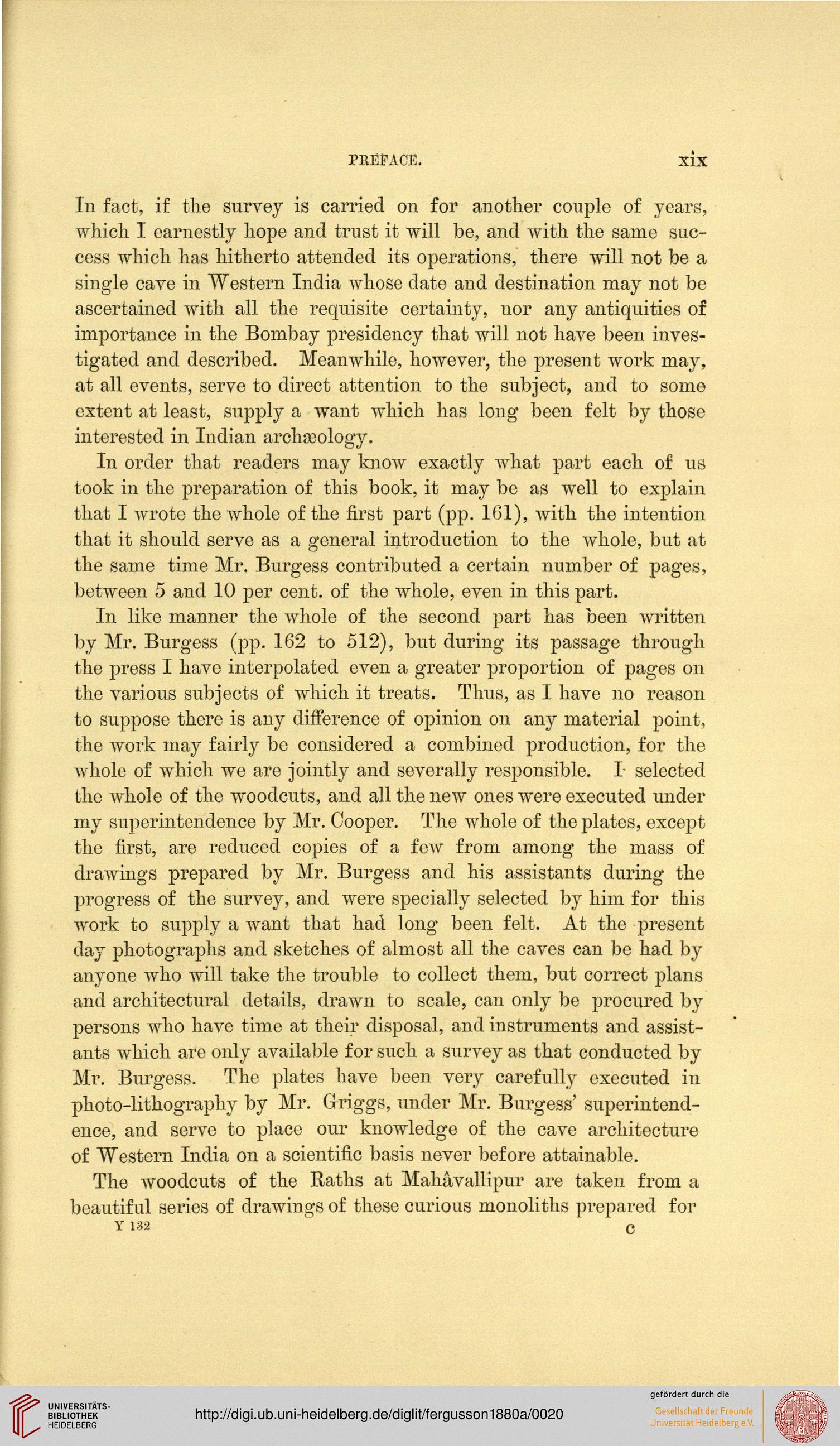PREFACE. XIX
In fact, if the survey is carried on for another couple of years,
which I earnestly hope and trust it will be, and with the same suc-
cess which has hitherto attended its operations, there will not be a
single cave in Western India whose date and destination may not be
ascertained with all the requisite certainty, nor any antiquities of
importance in the Bombay presidency that will not have been inves-
tigated and described. Meanwhile, however, the present work may,
at all events, serve to direct attention to the subject, and to some
extent at least, supply a want which has long been felt by those
interested in Indian archaeology.
In order that readers may know exactly what part each of us
took in the preparation of this book, it may be as well to explain
that I wrote the whole of the first part (pp. 161), with the intention
that it should serve as a general introduction to the whole, but at
the same time Mr. Burgess contributed a certain number of pages,
between 5 and 10 per cent, of the whole, even in this part.
In like manner the whole of the second part has been written
by Mr. Burgess (pp. 162 to 512), but during its passage through
the press I have interpolated even a greater proportion of pages on
the various subjects of which it treats. Thus, as I have no reason
to suppose there is any difference of opinion on any material point,
the Avork may fairly be considered a combined production, for the
whole of which we are jointly and severally responsible. I- selected
the whole of the woodcuts, and all the new ones were executed under
my superintendence by Mr. Cooper. The whole of the plates, except
the first, are reduced copies of a few from among the mass of
drawings prepared by Mr. Burgess and his assistants during the
progress of the survey, and were specially selected by him for this
work to supply a want that had long been felt. At the present
day photographs and sketches of almost all the caves can be had by
anyone who will take the trouble to collect them, but correct plans
and architectural details, drawn to scale, can only be procured by
persons who have time at their disposal, and instruments and assist-
ants which are only available for such a survey as that conducted by
Mr. Burgess. The plates have been very carefully executed in
photo-lithography by Mr. Grriggs, under Mr. Burgess' superintend-
ence, aud serve to place our knowledge of the cave architecture
of Western India on a scientific basis never before attainable.
The woodcuts of the Raths at Mahavallipur are taken from a
beautiful series of drawings of these curious monoliths prepared for
Y 132 c
In fact, if the survey is carried on for another couple of years,
which I earnestly hope and trust it will be, and with the same suc-
cess which has hitherto attended its operations, there will not be a
single cave in Western India whose date and destination may not be
ascertained with all the requisite certainty, nor any antiquities of
importance in the Bombay presidency that will not have been inves-
tigated and described. Meanwhile, however, the present work may,
at all events, serve to direct attention to the subject, and to some
extent at least, supply a want which has long been felt by those
interested in Indian archaeology.
In order that readers may know exactly what part each of us
took in the preparation of this book, it may be as well to explain
that I wrote the whole of the first part (pp. 161), with the intention
that it should serve as a general introduction to the whole, but at
the same time Mr. Burgess contributed a certain number of pages,
between 5 and 10 per cent, of the whole, even in this part.
In like manner the whole of the second part has been written
by Mr. Burgess (pp. 162 to 512), but during its passage through
the press I have interpolated even a greater proportion of pages on
the various subjects of which it treats. Thus, as I have no reason
to suppose there is any difference of opinion on any material point,
the Avork may fairly be considered a combined production, for the
whole of which we are jointly and severally responsible. I- selected
the whole of the woodcuts, and all the new ones were executed under
my superintendence by Mr. Cooper. The whole of the plates, except
the first, are reduced copies of a few from among the mass of
drawings prepared by Mr. Burgess and his assistants during the
progress of the survey, and were specially selected by him for this
work to supply a want that had long been felt. At the present
day photographs and sketches of almost all the caves can be had by
anyone who will take the trouble to collect them, but correct plans
and architectural details, drawn to scale, can only be procured by
persons who have time at their disposal, and instruments and assist-
ants which are only available for such a survey as that conducted by
Mr. Burgess. The plates have been very carefully executed in
photo-lithography by Mr. Grriggs, under Mr. Burgess' superintend-
ence, aud serve to place our knowledge of the cave architecture
of Western India on a scientific basis never before attainable.
The woodcuts of the Raths at Mahavallipur are taken from a
beautiful series of drawings of these curious monoliths prepared for
Y 132 c





